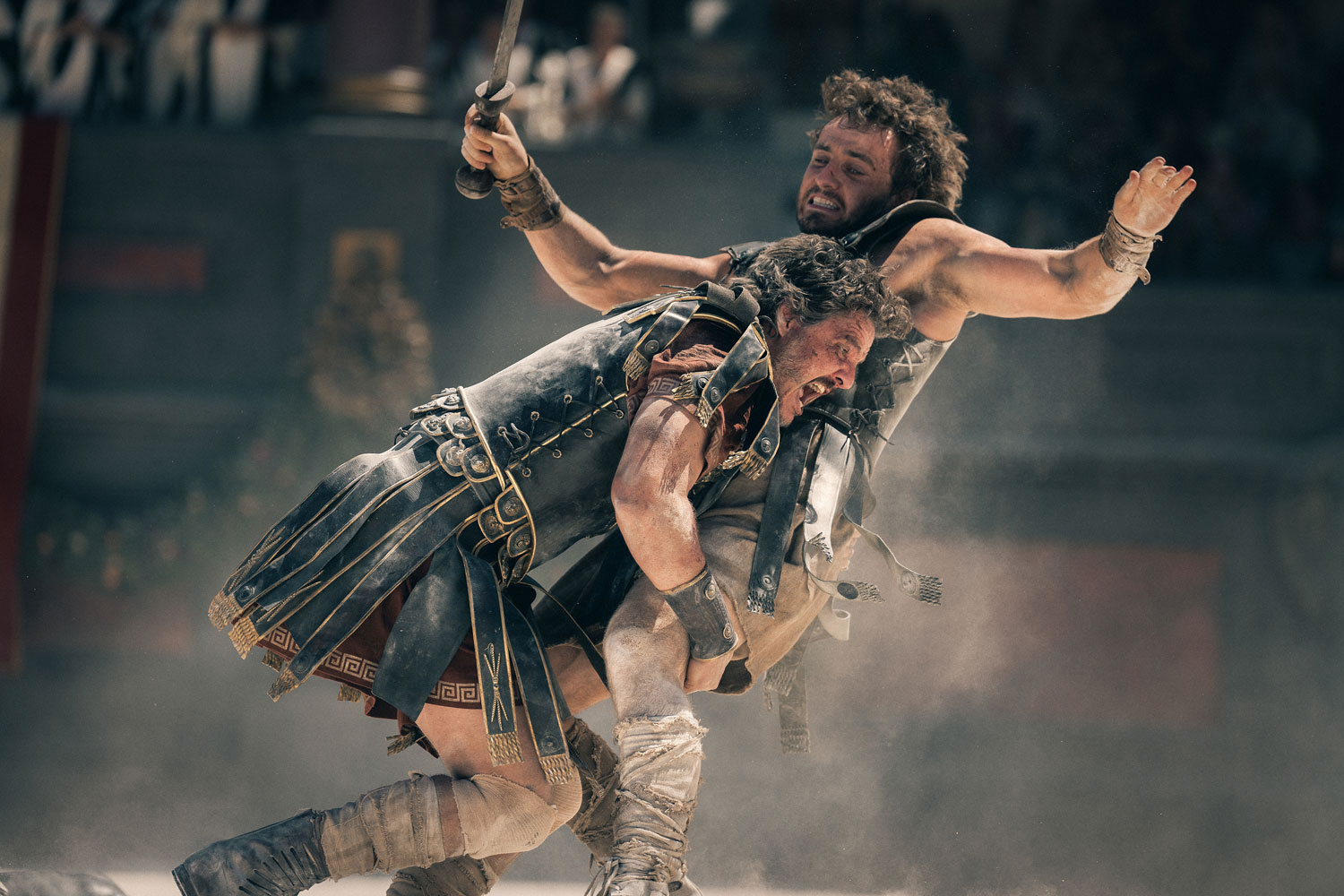
Pedro Pascal as General Acacius and Paul Mescal as "Hanno"/Lucius in a scene from "Gladiator II." (Photo courtesy of Paramount Pictures)
Ruben Rosario, Film Critic
The sobering statistic packs a wallop. By the end of the Year of Our Lord 2024, the top 10 box office hits in North America are all expected to be sequels. The writing has been on the wall for at least the past five years, with the handful of non-sequel titles still mining popular intellectual properties. Still, not the happy news your intrepid critic was hoping to read as a very eventful, tumultuous November draws to a close.
We have a month and change to go before the year ends, and there's no way around it: This cinemaniac, and frequent cinemasochist, is underwhelmed with the crop of movies the past 11 months have brought to these shores. I will unveil the notable exceptions in a few weeks.
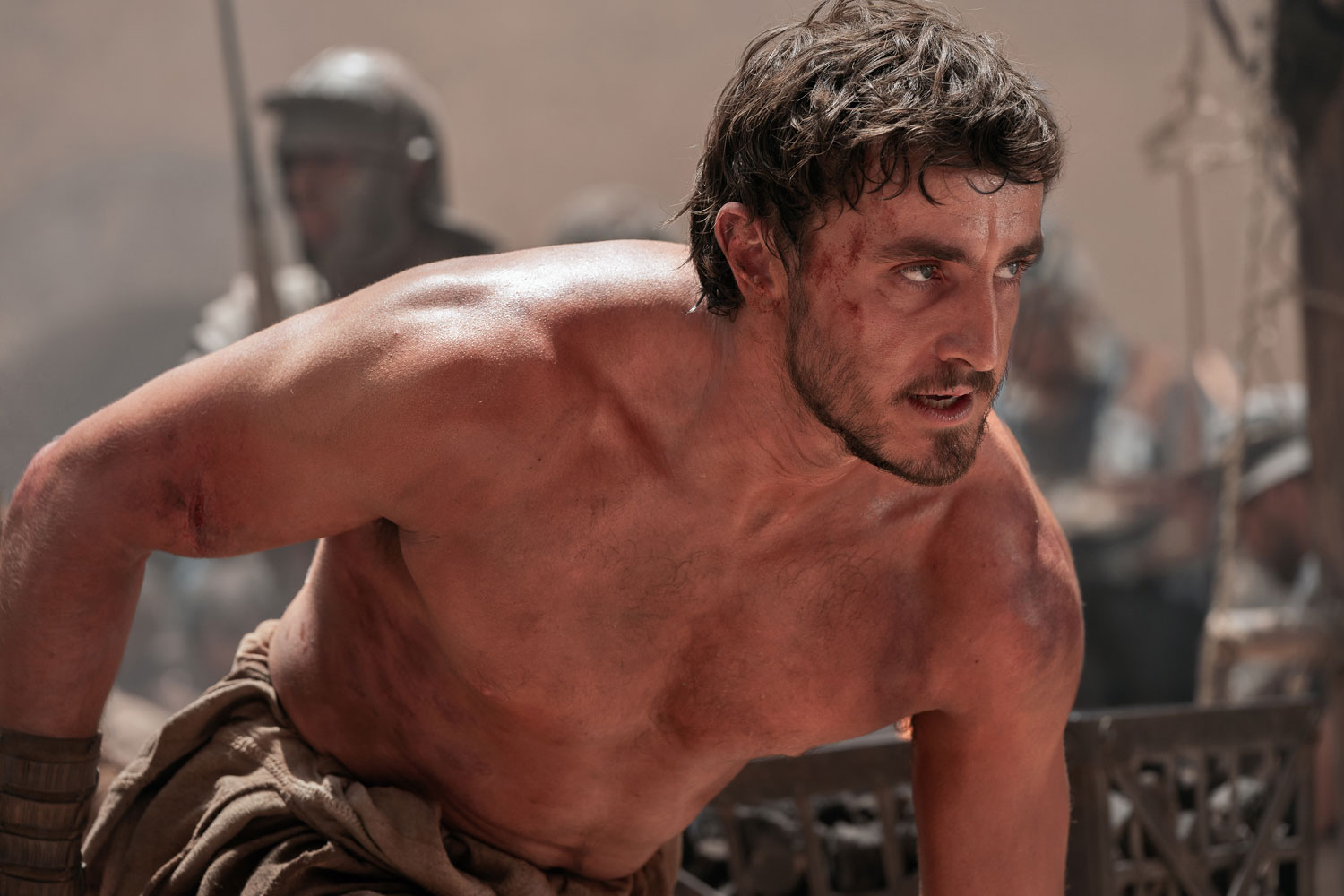
Paul Mescal as "Hanno"/Lucius in a scene from "Gladiator II." (Photo courtesy of Paramount Pictures)
It's clear the moviegoing public is not displaying follow-up fatigue, as those of us hungering for more original stories are left fighting for table scraps. Granted, not all sequels are created the same, and two new releases drawing in sizable crowds appear to have more going for them than your basic, sequelitis-afflicted Part Twos. This high-profile pair hopes to fire up enthusiasm among multiple demographics, enough for them to part with their hard-earned cash. Are they worth braving through holiday traffic and inconsiderate ticket buyers who treat your neighborhood multiplex auditorium like their living room? Let's dive in.
“Gladiator II”: Remember when Ridley Scott took your breath away? The “Alien” and “Thelma & Louise” auteur turned entire landscapes into his very own photo shoot, engulfing his actors in plumes of smoke and drowning the soundtrack with booming chords from Vangelis and Hans Zimmer. Whether it was the shadowy nooks and crannies of a spaceship, the overpopulated streets of a bracingly futuristic Los Angeles, or the vast expanse of the Grand Canyon, the veteran British filmmaker conjured up entire worlds with his killer widescreen compositions, even when the textures were far more arresting than the stories he told.
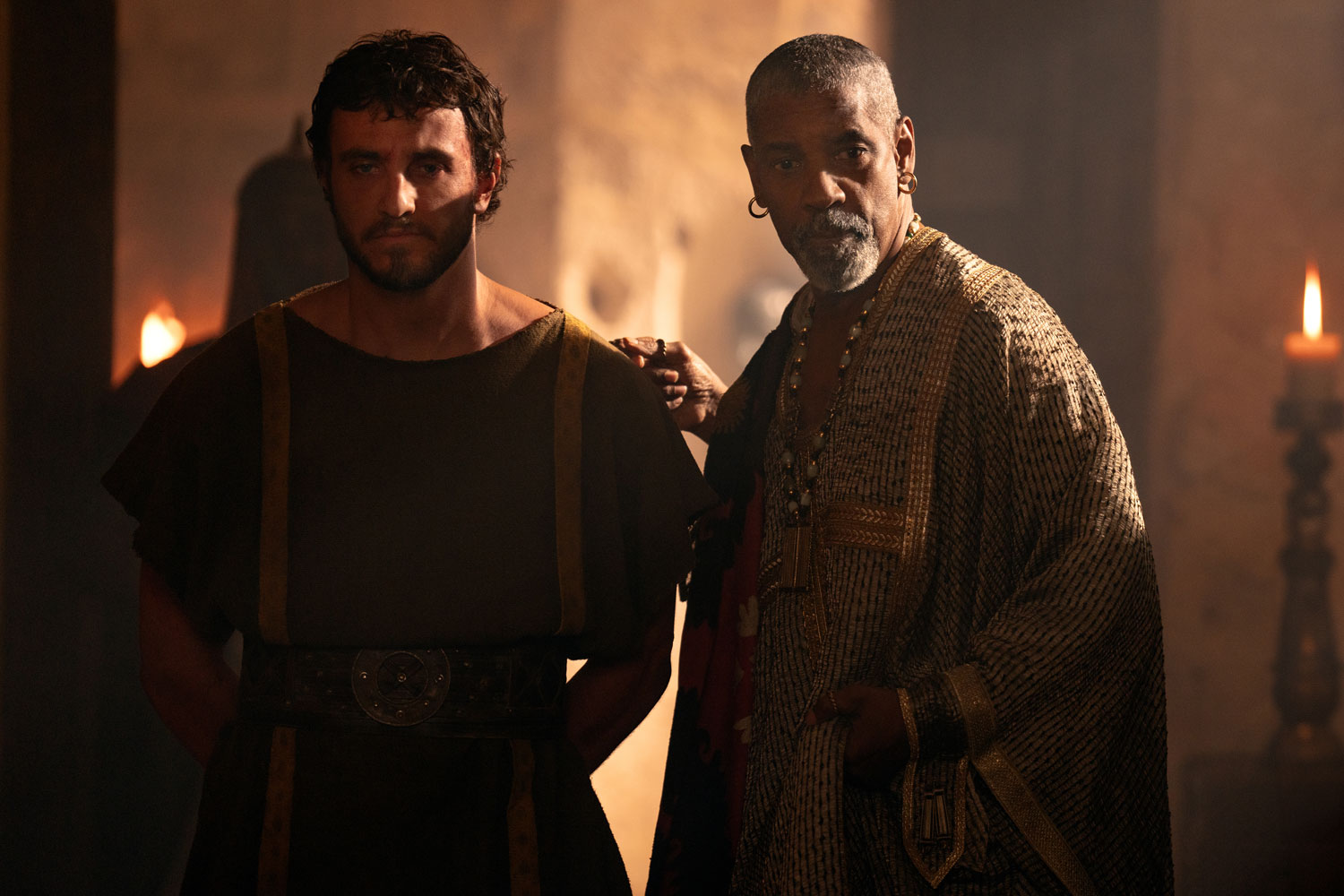
Paul Mescal as "Hanno"/Lucius and Denzel Washington as Macrinus in a scene from "Gladiator II." (Photo courtesy of Paramount Pictures)
There are faint glimmers of vintage Ridley in “Gladiator II.” A haunting glimpse of the passage to the underworld early in the film immediately springs to mind. But the sad reality is that Ridley the purveyor of lush visual poetry has evolved into Ridley the functional nuts-and-bolts storyteller, and though this new legacy shows the filmmaker, who turns 87 on Saturday, regaining a fraction of his old mojo, this sword-and-sandal endeavor feels perfunctory and impersonal, a not-quite-worthy continuation of his solid, 2000 Best Picture Oscar-winning juggernaut.
It's 211 A.D., 16 years after Russell Crowe's titular Maximus Decimus Meridius met his fate (or, I should say, Fates) in the arena after taking out Joaquin Phoenix's Emperor Commodus. The Roman Empire, under the iron thumb of sibling rulers Geta (Joseph Quinn) and Caracalla (Fred Hechinger), is in irrevocable decline. Still, the quest to acquire more territories is in full swing, and minutes after “Gladiator II” gets underway, General Acacius (Pedro Pascal) is taking care of business in North Africa, where Numidia falls following a valiant effort by the local army.
Nowhere is Scott's current going-through-the-motions indifference more apparent than in the battle sequence that opens the movie, which recalls his similarly lackluster Moses epic “Exodus: Gods and Kings” in its deflating point-and-shoot listlessness. The stakes are supposed to be high, because among those fighting for Numidia is a strapping young leader (Paul Mescal) who goes by “Hanno” and his wife Arishat (Yuval Gonen), who's handy with a bow and arrow. But when tragedy strikes, this viewer felt ... numb.
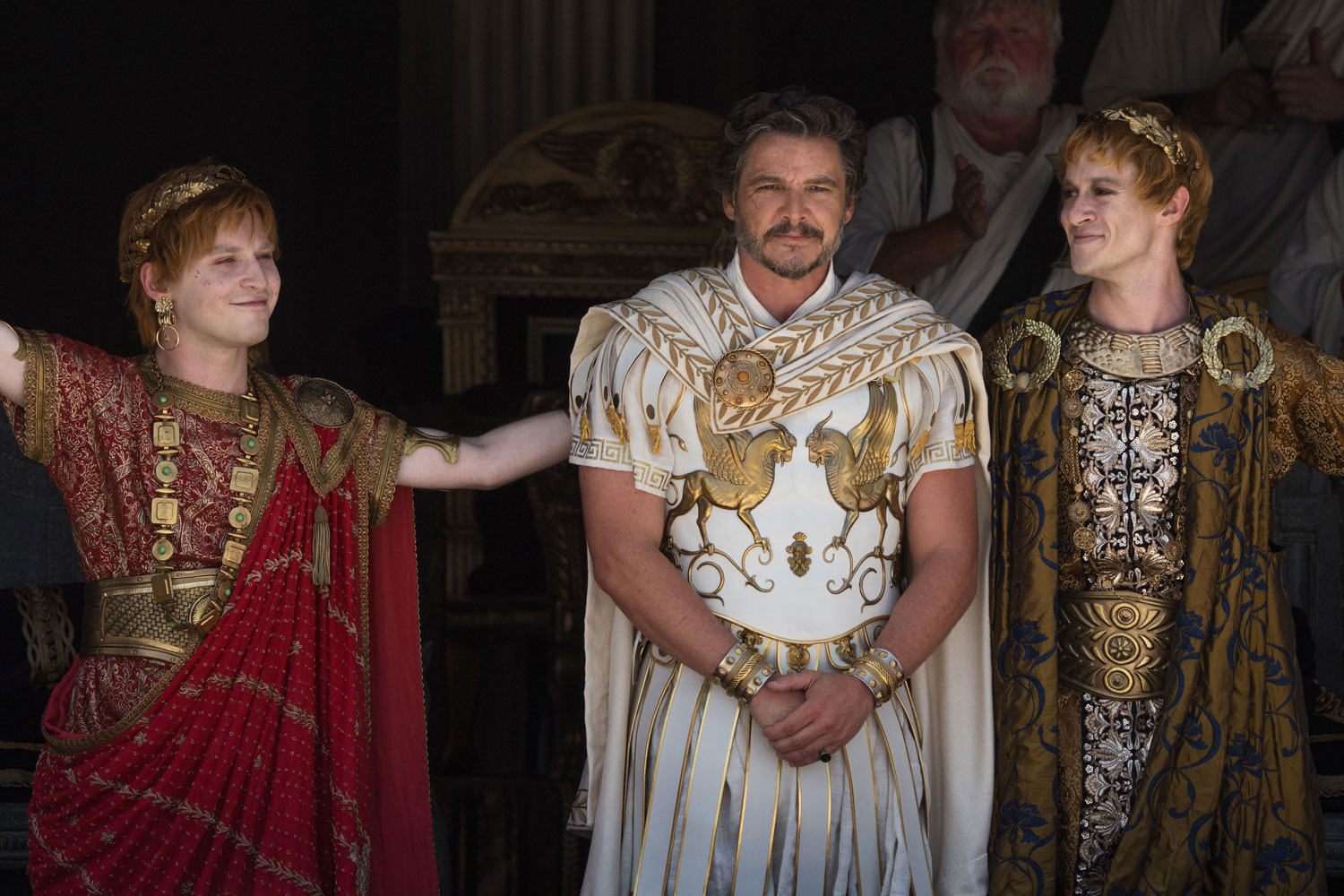
Fred Hechinger as Emperor Caracalla, Pedro Pascal as General Acacius and Joseph Quinn as Emperor Geta in a scene from "Gladiator II." (Photo courtesy of Paramount Pictures)
“Hanno,” not his real name, is enslaved and soon after catches the eye of Macrinus (a deliciously overqualified Denzel Washington), who's in the slave business but has much bigger aspirations. A handshake contract of sorts is struck: If he wins enough fights to the death, duly entertaining the masses at the Colosseum, “Hanno,” Macrinus promises, will get a crack at offing Acacius, whom the seething warrior holds responsible for Arishat's untimely passing.
Revenge plot firmly in place, Scott, working from a screenplay by David Scarpa, turns his attention to the palace intrigue brewing behind closed doors, where the walls have ears. The twin emperors, disenchanted hometown hero Acacius argues to those who will listen, are a hot mess, Geta a greedy little bastard with a chip on his shoulder and an unchecked lust for power, Caracalla a libidinous doofus with an STD and a penchant for the company of young men. There's also the matter of “Hanno's” real identity, revealing him as someone who's no stranger to the world of “Gladiator,” someone who could play a pivotal role turning the tide in the tricky efforts to get rid of these dual despots and restoring stability to Rome.
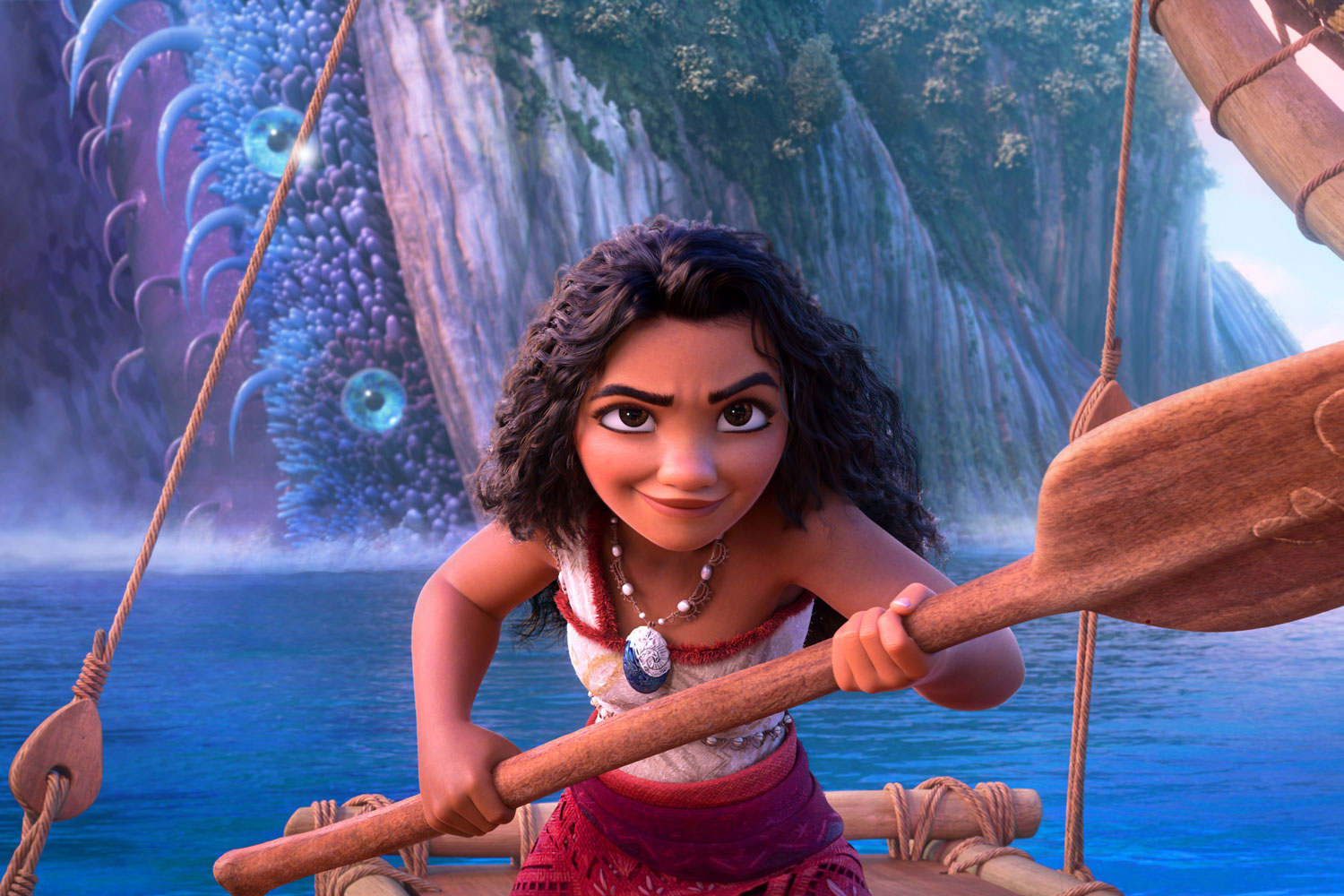
Auli'i Cravalho voices Moana in a scene from "Moana 2." (Photo courtesy of Disney)
Add the bloody arena brawls to the mix, and Scott is juggling a lot of balls story-wise. “Gladiator II” is not boring, but it flits from one narrative strand to another with haphazard, herky-jerky momentum. The sequel is at its best when it embraces its (often historically inaccurate) silliness. Scott throws CGI baboons, a realistic CGI rhino and shoddy, B-movie CGI sharks at you, and that's when the movie perks up. Washington's scenery-chewing falls back on tried-and-true Washingtonian tics and mannerisms, but whenever he's onscreen, there's no doubt that “Gladiator II” springs to life. (The Oscar winner's pronunciation of the word “politics” as POL-ee-TICS-uh? Mm-mmm, tasty.)
But Macrinus is not the main player here; Scott has entrusted Mescal with carrying this uneven sequel on his shoulders. I can see where the director's reasoning comes from: a desire to veer away from the brawny masculinity Crowe brought to the table in favor of something more vulnerable and delicate. (Scott made a similar move when he cast Orlando Bloom as the lead of his Crusades epic “Kingdom of Heaven.”) But the Irish-born Mescal, terrific in “Aftersun” and “All of Us Strangers,” is in over his head here. He's an ill fit to play this leader of men with the mad slicing and dicing skills. To be fair, that doesn't tell the whole story.
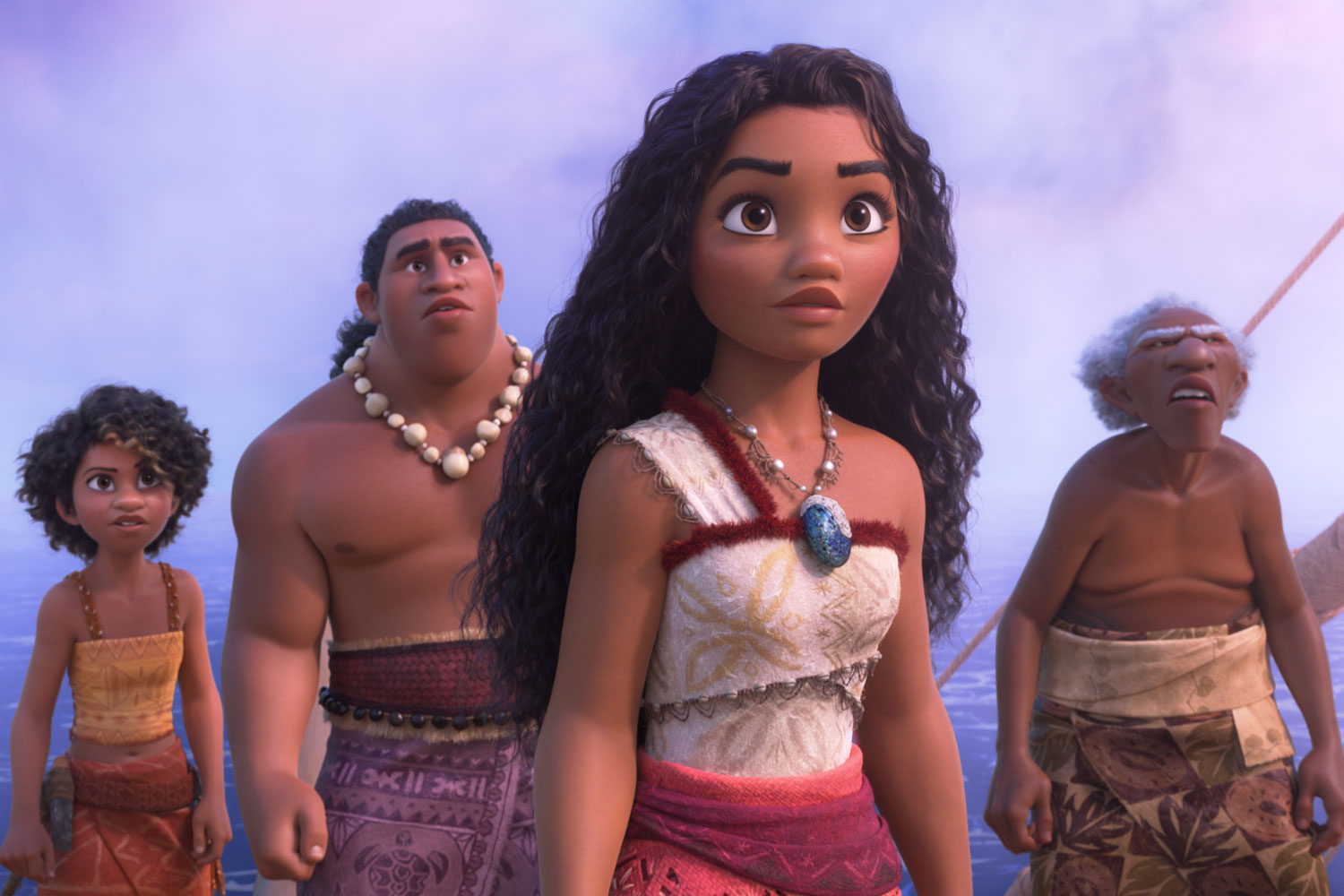
Rose Matafeo voices Loto, Hualalai Chung voices Moni, Auli'i Cravalho voices Moana and David Fane voices Kele in a scene from "Moana 2." (Photo courtesy of Disney)
Because there's a wilder, more unhinged toga dress-up yarn here trying to wrest free from its constraints, one that would use the ways Mescal's character struggles with having leadership thrust upon him to its advantage. Thing is, Scott and Scarpa double down on callbacks to the first film, underlining how “Hanno” has what it takes to live up to the promise of his lineage, a revelation that lands with a dull thud. Then Scott drops the ball with a climactic mano-a-mano so tired, it feels like it's doused in formaldehyde. It's a creative dead end for an undertaking that's a little better than Scott's last couple of movies not named “The Last Duel,” and certainly a step up from last year's lethargic “Napoleon,” but still very much a big-screen spectacle that spends two and a half hours unsuccessfully trying to justify its existence. This thumb is turned slightly down.
“Moana 2”: Representation matters in the wonderful world of Disney, and until “Moana” came out in 2016, Pacific Islander representation was a unicorn. “Lilo & Stitch,” with its delightfully kooky depiction of Native Hawaiians, got the ball rolling back in 2002, which just goes to show you how rare mainstream movies with prominent characters from the Pacific Islands are.
The new sequel to the rousing, exquisitely animated “Moana” is the lesser of these three features, with a warmed-over plot that feels like secondhand goods, songs that are nowhere near as memorable as the Lin-Manuel Miranda-composed earworms in its predecessor, not to mention its half-baked, weak tea mythology. The odds are stacked against a production that was originally envisioned as a Disney Plus series.
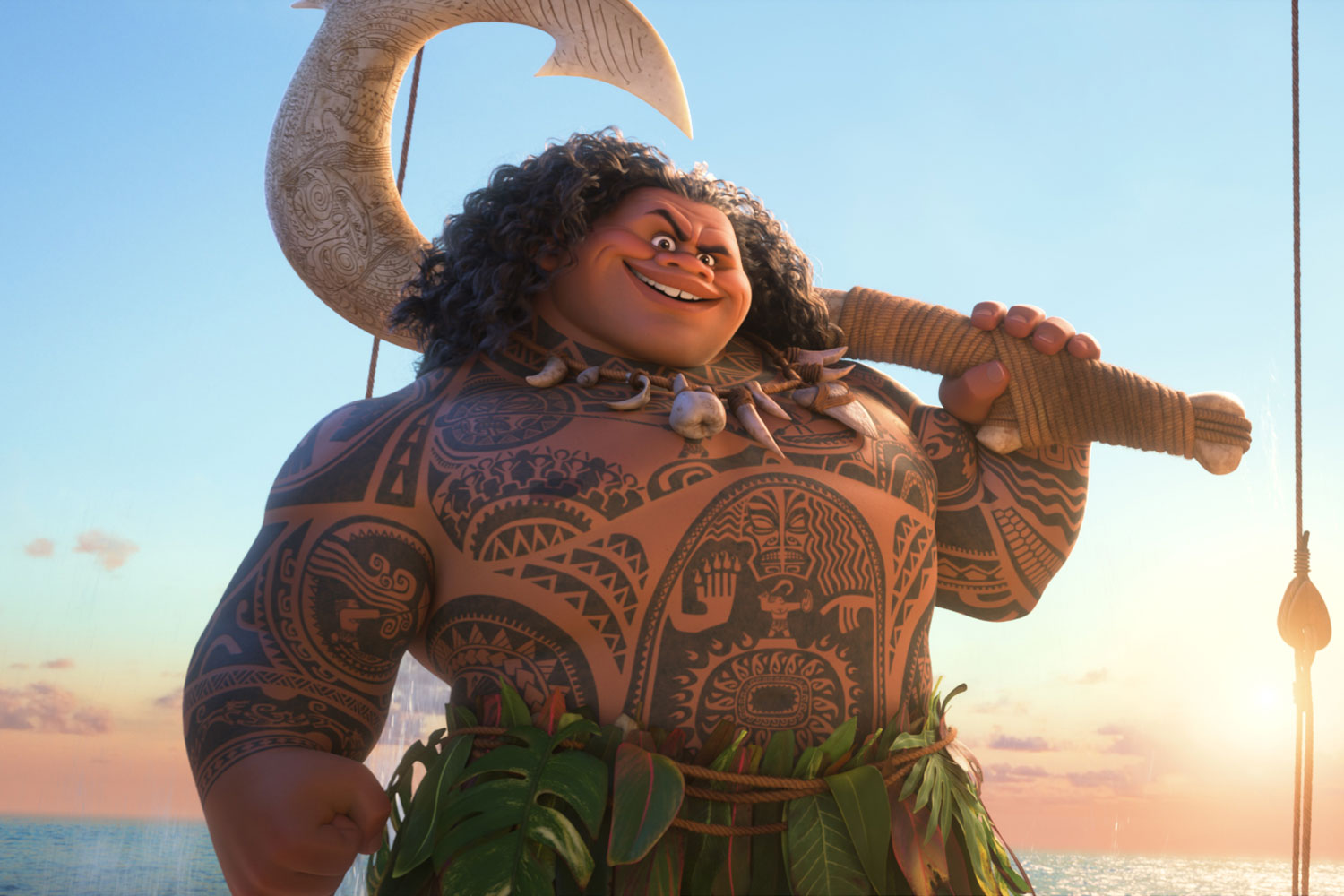
Dwayne Johnson voices Maui in a scene from "Moana 2." (Photo courtesy of Disney)
But there's a reason why the powers that be at the Mouse House saw the potential for this material to play as a theatrical feature, a pointed reversal from having too many Disney and Disney-Pixar films that never got their due and were instead sent straight to the entertainment conglomerate's streaming service, do not pass Go. This executive decision to roll out the red carpet has paid off, because, despite the considerable issues I have with it, this amiable sequel is lighthearted fun, spry and nimble and heartfelt and, like Part One, gorgeously rendered.
The film picks up three years after the events of the first “Moana.” It's titular heroine, once again voiced by the charismatic Auli'i Cravalho, has become a rock star in her community, thanks to her navigational skills and indefatigable efforts to find other people, even though their location, the (fictional) South Pacific island of Motunui, is the proverbial needle in a haystack. But finding a broken piece of pottery on a deserted island she visits during one of her wayfinding voyages is all the motivation that Moana, once again rocking flowing jet-black hair that looks freshly shampooed, needs to keep going.
Impressed by her tenacity, her tribe leader dad, Chief Tui (the voice of Temuera Morrison) gives her a promotion of sorts, designating her the kind of celestial navigation guru that only comes along once in a millennium. But the naming ceremony is cut short by a sudden bolt of lightning and a dark vision that tells her the way forward is simply to follow what appears to be comet. Also, this trip is gonna be very, very dangerous.
Moana's accomplishments, you see, have caught the attention of Nalo (Tofiga Fepulea'i), an evil god who guards the sunken island of Motufetu, the very place that, Moana's vision tells her, she must find to locate and connect other people who, like Tui's tribe, are searching for signs of intelligent life in the vast, turquoise waters of the Pacific.
So off Moana goes, accompanied by a skeleton crew that includes her trusted pig Pua and bug-eyed chicken Heihei, in search of this mysterious island, fully aware of the perils she might encounter. As expected, this motley crew is on a collision course with Maui (Dwayne Johnson), the cocky demigod who joined forces with Moana last time around. Forgettable tunes and inspired sight gags ensue. (I never thought I'd ever be missing Lin-Manuel Miranda's creative input, but here we are.)
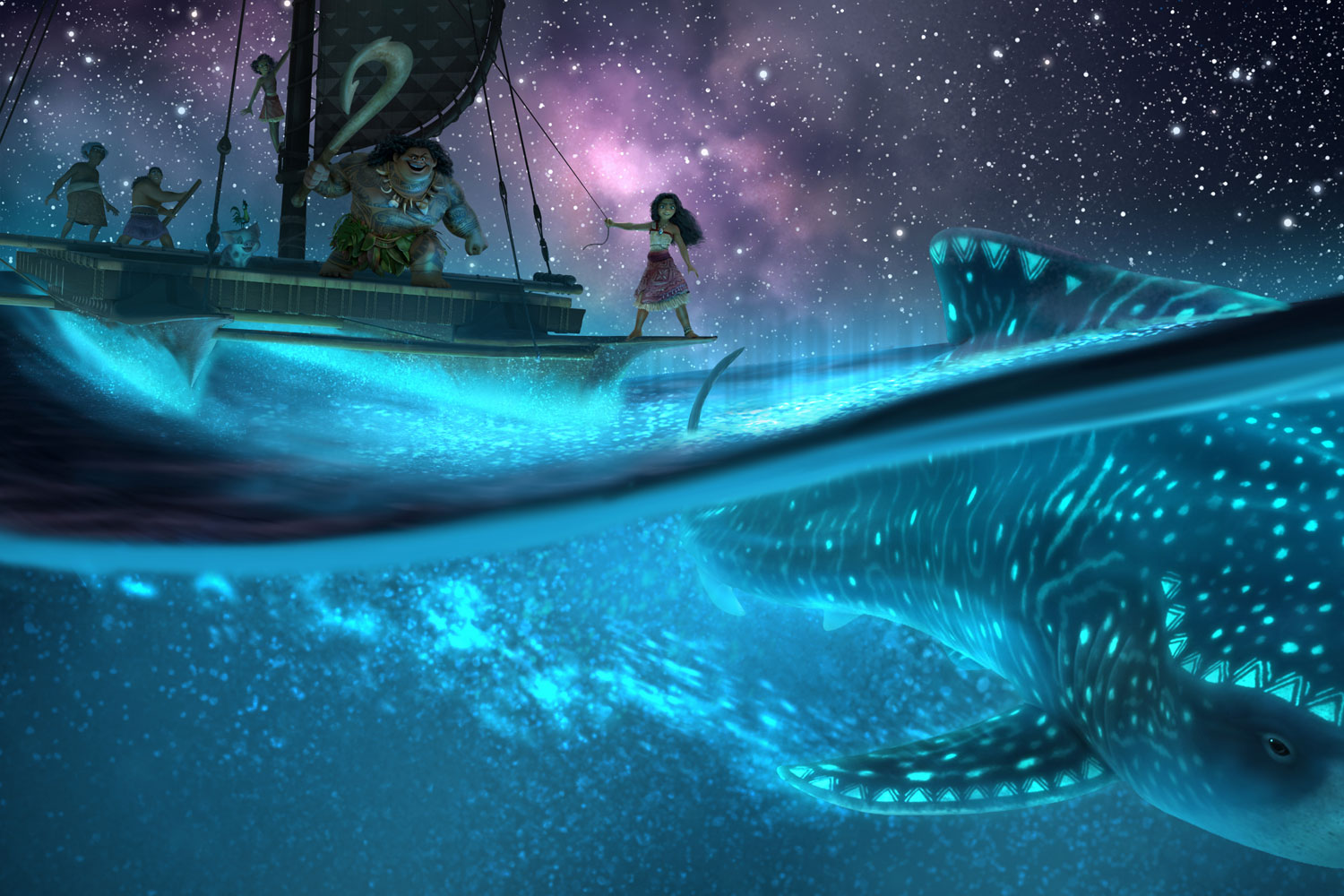
David Fane voices Kele, Hualalai Chung voices Moni, Rose Matafeo voices Loto, Dwayne Johnson voices Maui and Auli'i Cravalho voices Moana in a scene from "Moana 2." (Photo courtesy of Disney)
If “Moana 2” sounds like kiddie fare, that's because it is, and its unabashedly kid-friendly antics are key to its disarming appeal. This sequel clocks in at 100 minutes and fills every second with bright, visually arresting dering-do and nifty slapstick, in sharp contrast to the current trend of inflating multiplex fare well past the two-hour mark.
Directors David Derrick Jr., Jason Hand and Dana Ledoux Miller understand that, when it comes to adventures of the cute, warm and cuddly kind like this one, less is more. It's noteworthy how much character detail they're able to pack into its relatively slim runtime, not just with Moana but with the supporting characters, which include a scene-stealing Kakamora, aka one of those diminutive coconut people fond of tranquilizer darts.
The filmmakers' ace in the hole is making Moana's relationship with her baby sister Simea (Khaleesi Lambert-Tsuda) the heart of their story. Simea's separation anxiety remains in the back of Moana's mind, thus giving this decent follow-up a satisfying emotional core. There are no surprises on this guided tour of the islands, but as Thanksgiving weekend matinee fare goes, this likable, proudly cartoonish time-filler delivers the worldbuilding goods with throwback flair. It charts well-trodden territory capably enough to rise above a tidal wave of shortcomings.
“Gladiator II” and “Moana 2” are currently in theaters across South Florida in wide release, including IMAX engagements for “Gladiator II” at Regal South Beach, AMC Aventura 24, AMC Sunset Place 24 and CMX Dolphin 19. Both films are also showing at the AutoNation IMAX at the Museum of Discovery and Science in downtown Fort Lauderdale.
 MAIN MENU
MAIN MENU

